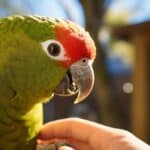Kakarikis are small, colourful parakeets that are native to New Zealand. Many bird enthusiasts are drawn to these lively creatures for their playful nature and entertaining antics. However, there is often confusion surrounding their temperament, leaving many wondering if kakarikis are aggressive birds.
Are Kakarikis Aggressive? Kakarikis, on the whole, are not typically aggressive. However, like many birds, individual temperaments can vary. Some may show signs of territorial behaviour or might be assertive with other birds, especially in limited space. Monitoring their behaviour, ensuring a spacious environment, and engaging in positive socialisation practises to maintain harmony are essential.
While not typically aggressive, kakarikis do have the potential to display aggressive behaviour, just like any other animal. Their natural instincts and environment can influence their behaviour, sometimes leading to aggression.
To better understand kakariki behaviour, we must first explore their overall temperament and behavioural traits.
Key Takeaways:
- Kakarikis are small, colourful parakeets native to New Zealand.
- While not typically aggressive, kakarikis have the potential to display aggressive behaviour.
- Understanding the instincts and environment of kakarikis is crucial in managing their behaviour.
Understanding Kakariki Behaviour
Kakarikis are known to be lively and social birds. They are quick learners and curious, making them fascinating pets. However, they can also display aggressive behaviour, which can concern pet owners. Understanding the behavioural patterns of kakarikis is crucial to managing and preventing aggression in these birds.
Kakarikis are highly social animals and thrive on interaction with other birds and humans. Like parrots, they are intelligent and expressive creatures that can bond strongly with their owners. However, they can also become jealous and territorial, especially if their needs are not met.
Signs of aggressive behaviour in kakarikis can include biting, screeching, or attacking other birds or humans. Aggression can manifest as destructive behaviour, such as chewing on furniture or cages. Observing your bird’s behaviour closely is essential to recognising the signs of aggression and taking appropriate action to manage it.
One way to prevent aggression in kakarikis is to provide adequate environmental enrichment. This can include toys, perches, and other items that simulate their natural environment and provide mental stimulation. Proper socialisation is also crucial to preventing aggressive behaviour in kakarikis. Introduce them to other birds and humans from a young age, and expose them to various experiences to ensure they are well-adjusted and confident animals.
If your kakariki displays aggressive behaviour, there are several techniques that you can use to manage it. One approach is redirecting their aggression towards more appropriate outlets, such as toys or other activities. Positive reinforcement is also essential to shaping their behaviour effectively. Reward them for good behaviour and avoid punishing them for aggressive behaviour, as this can reinforce negative behaviour patterns.
Finally, establishing a consistent kakariki routine can help manage and prevent aggression. This can include regular training sessions, mealtimes and playtimes, and other daily activities that help to establish a sense of routine and structure. By understanding the behavioural patterns of kakarikis and applying these techniques, pet owners can manage and prevent aggressive behaviour in these fascinating birds.
Factors Influencing Aggression in Kakarikis
A variety of factors can contribute to aggression in Kakarikis. Social birds require proper socialisation from a young age to prevent aggressive behaviour. Kakarikis that lack socialisation may become defensive or territorial, leading to aggressive tendencies towards humans and other pets.
Environmental factors can also play a role in Kakariki aggression. Overcrowding, lack of space, or insufficient environmental enrichment can cause stress and frustration in birds, leading to negative behaviours such as aggression. Providing ample space for exercise, toys for entertainment, and a stimulating environment can prevent boredom and reduce the risk of aggression.
Training techniques and handling practises can also influence kakarikis’ behaviour. Positive reinforcement and consistent training can encourage desired behaviours and discourage aggression. Conversely, punishment or negative reinforcement can cause fear and anxiety in birds, exacerbating aggressive tendencies.
Lastly, genetics may also play a role in Kakariki aggression. Some birds may have a more aggressive temperament due to their breeding history, which can be difficult to overcome with training and socialisation alone. In such cases, it is important to seek the advice of an avian behaviourist to address the issue.
Tips for Managing and Preventing Aggression in Kakarikis
If you’re dealing with an aggressive kakariki, taking steps to manage and prevent this behaviour is important. Here are some tips to help you tame and train your bird:
Establish Trust
Building a bond of trust with your kakariki is crucial for managing aggression. Spend time with your bird daily, speaking to them calmly and reassuringly. Offer treats from your hand and let them explore their surroundings on their terms. Avoid sudden movements or loud noises that can startle them.
Redirect Aggression
If your kakariki starts to display aggressive behaviour, it’s important to redirect their attention to a more appropriate outlet. Please provide them with toys and activities encouraging them to engage in natural behaviours, such as foraging and playing. This can help them release pent-up energy and aggression safely and under control.
Consistency is Key
When it comes to training your kakariki, consistency is crucial. Establish a routine that includes regular feeding and playtime, and stick to it as closely as possible. Use positive reinforcement techniques, such as offering treats or praise when your bird exhibits desirable behaviour, to encourage them to perform more positive actions.
Enrich the Environment
Providing your kakariki with a stimulating environment can help prevent boredom and aggression. Offer them a variety of toys, perches, and other accessories that allow them to explore and play. Rotate these items regularly to keep them engaged.
Seek Professional Help
If your kakariki’s aggression is persistent or severe, it may be necessary to seek professional help. A qualified avian veterinarian or bird behaviourist can assess your bird’s behaviour and advise on managing and preventing aggression.
Tips for Managing and Preventing Aggression in Kakarikis
While aggression in kakarikis can be concerning for bird owners, several tips and techniques can be used to manage and prevent it. Here are some practical tips to help build a positive and trusting relationship with your feathered friend:
Establish trust
When dealing with aggressive kakarikis, it’s important to establish trust before attempting to handle them. Spend time near their cage, offering treats and talking softly to them. Over time, they will become more comfortable with your presence and more receptive to socialisation.
Redirect their aggression
Providing appropriate outlets for your kakariki’s aggression can help prevent it from turning towards you. Offer chew toys and bird-safe objects for them to play with and chew on, stimulating their minds and reducing boredom.
Consistent routine
Establishing a consistent routine for your kakariki can help reduce stress and anxiety, which can contribute to aggression. This includes regular feeding times, playtime, and a consistent sleep schedule.
Positive reinforcement
Positive reinforcement, such as giving treats or offering praise, can be an effective way to shape your kakariki’s behaviour. Reinforcing positive actions, such as stepping up onto your hand, can help build a strong bond of trust and discourage aggressive behaviour.
Seek professional help
If you struggle to manage your kakariki’s aggression, seek help from a professional bird trainer or behaviourist. They can provide personalised advice and support to help you and your feathered friend build a positive and loving relationship.
Using these tips and techniques, you can successfully manage and prevent aggression in your kakariki, helping build a strong and loving bond between you and your feathered friend.
FAQ
Q: Are kakarikis aggressive?
A: Kakarikis can exhibit aggressive behaviour, but it is important to understand the factors that influence their temperament and how to manage and prevent aggression in these birds.
Q: What are some signs of aggressive behaviour in kakarikis?
A: Signs of aggression in kakarikis include biting, excessive screeching, territoriality, feather plucking, and aggression towards other birds or humans.
Q: How can aggression in kakarikis be managed and prevented?
A: Aggression in kakarikis can be managed and prevented through proper socialisation, environmental enrichment, training techniques, establishing trust and building a bond, redirecting aggression, and maintaining a consistent routine with positive reinforcement.
Q: What factors can contribute to aggression in Kakarikis?
A: Various factors, such as lack of socialisation, inadequate environmental enrichment, improper handling, and previous trauma or negative experiences, can contribute to aggression in kakarikis.
Q: How can aggressive kakarikis be tamed and handled?
A: Aggressive kakarikis can be tamed and handled using patience, consistency, positive reinforcement, gentle handling techniques, and gradually introducing them to new experiences.



Have comments or questions about this article? Then get involved!
Spotted an error or something we have missed? Let us know